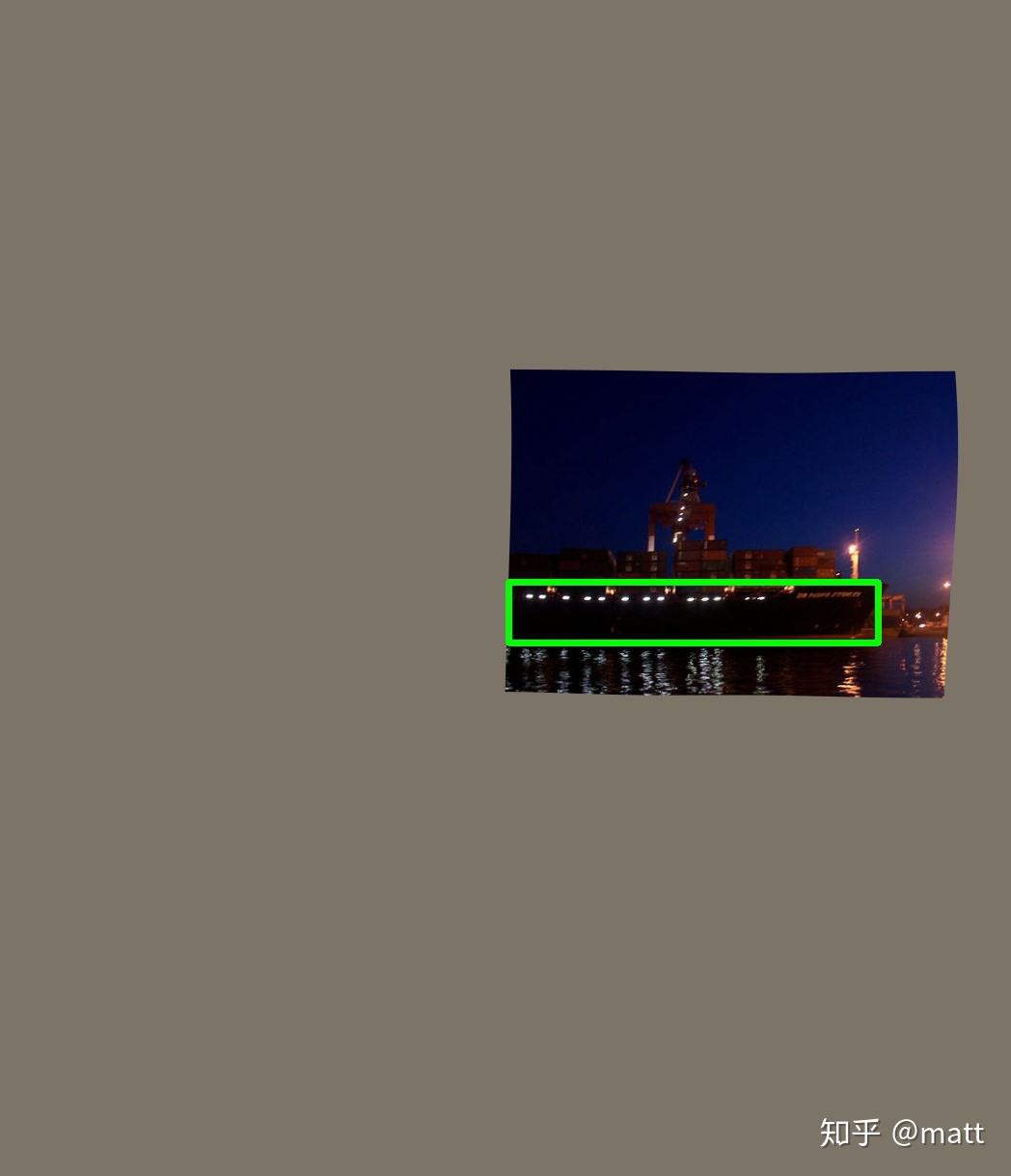在训练中对图片进行数据增强可以提高模型的泛化能力,目标检测中的数据增强方法跟普通的数据增强区别在于还要考虑boxunding box的变换。
常见的数据增强包括随机裁剪,扭曲,扩增,镜像,形变等。
随机裁剪
- 从图像中随机裁剪一个正方形区域roi
- 判断roi与各个目标框的iou,过小则重新裁剪
- 根据各个目标框的中心来选取在roi中的box
- 调整box的大小防止超出roi
def _crop(image, boxes, laels):
heigth, width, _ = image.shape
if len(boxes) == 0:
return image, boxes, laels
while True:
mode = random.choice((
None,
(0.1, None),
(0.3, None),
(0.5, None),
(0.7, None),
(0.9, None),
(None, None)
))
if mode is None:
return image, boxes, laels
min_iou, max_iou = mode
if min_iou is None:
min_iou = float('-inf')
if max_iou is None:
max_iou = float('inf')
# 多次迭代
for _ in range(50):
scale = random.uniform(0.3, 1.)
min_ratio = max(0.5, scale*scale)
max_ratio = min(2, 1./scale/scale)
ratio = math.sqrt(random.uniform(min_ratio, max_ratio))
# 随机裁剪的图片大小
w = int(scale*ratio*width)
h = int((scale/ratio)*heigth)
# 从0- width-w中选择一个起始点
l = random.randrange(width-w)
t = random.randrange(heigth-h)
roi = np.array([l, t, l+w, t+h])
# 计算目标框和待裁剪区域的iou大小 iou太小则重新选择
iou = matrix_iou(boxes, roi[np.newaxis])
if not (min_iou <= iou.min() and iou.max() <= max_iou):
continue
image_t = image[roi[1]:roi[3], roi[0]:roi[2]]
# 得到每个目标框中心点
centers = (boxes[:, :2] + boxes[:, 2:])/2
# 选择在roi区域的box
mask = np.logical_and(roi[:2] < centers, centers < roi[2:]).all(axis=1)
boxes_t = boxes[mask].copy()
laels_t = laels[mask].copy()
# 裁剪区域不存在目标 重新裁剪
if len(boxes_t) == 0:
continue
# 判断box是否超过roi范围并调整
boxes_t[:, :2] = np.maximum(boxes_t[:, :2], roi[:2])
boxes_t[:, :2] -= roi[:2]
boxes_t[:, 2:] = np.minimum(boxes_t[:, 2:], roi[2:])
boxes_t[:, 2:] -= roi[:2]
return image_t, boxes_t, laels_t
def matrix_iou(a,b):
lt = np.maximum(a[:, np.newaxis, :2], b[:, :2])
rb = np.minimum(a[:, np.newaxis, 2:], b[:, 2:])
area_i = np.prod(rb - lt, axis=2) * (lt < rb).all(axis=2)
area_a = np.prod(a[:, 2:] - a[:, :2], axis=1)
area_b = np.prod(b[:, 2:] - b[:, :2], axis=1)
return area_i / (area_a[:, np.newaxis] + area_b - area_i)随机扭曲
- 随机变换亮度,即对图像加减某个值
- 随机变换对比度,即像素点乘某个值
- 随机变换色度, 将图像转换到HSV空间,然后再加上某个值
- 随机变换饱和度 HSV的色彩空间乘某个值
def _distort(image):
def _convert(image, alpha=1, beta=0):
tmp = image.astype(float) * alpha + beta
tmp[tmp < 0] = 0
tmp[tmp > 255] = 255
image[:] = tmp
image = image.copy()
# 随机变换亮度
if random.randrange(2):
_convert(image, beta=random.uniform(-32, 32))
# 随机变换对比度
if random.randrange(2):
_convert(image, alpha=random.uniform(0.5, 1.5))
# 将图片转到HSV空间
image = cv2.cvtColor(image, cv2.COLOR_BGR2HSV)
# 随机色度变换
if random.randrange(2):
tmp = image[:, :, 0].astype(int) + random.randint(-18, 18)
tmp %= 180
image[:, :, 0] = tmp
# 随机变换饱和度
if random.randrange(2):
_convert(image[:, :, 1], alpha=random.uniform(0.5, 1.5))
image = cv2.cvtColor(image, cv2.COLOR_HSV2BGR)
return image随机扩增
- 随机产生一个新的正方形区域roi(大于原始图像)
- 将原始图像放入roi中
- 调整box
- 空白区域使用图像均值填充
def _expand(image, boxes, fill, p):
# 超过某个概率则不进行扩增
if random.random() > p:
return image, boxes
height, width, depth = image.shape
for _ in range(50):
scale = random.uniform(1, 4)
min_ratio = max(0.5, 1./scale/scale)
max_ratio = min(2, scale*scale)
ratio = math.sqrt(random.uniform(min_ratio, max_ratio))
# 获得扩张后图片大小
ws = scale*ratio
hs = scale/ratio
if ws < 1 or hs < 1:
continue
w = int(ws*width)
h = int(hs*height)
left = random.randint(0, w - width)
top = random.randint(0, h - height)
# 调整目标框在新图片中位置
boxes_t = boxes.copy()
boxes_t[:, :2] += (left, top)
boxes_t[:, 2:] += (left, top)
expand_image = np.empty((h, w, depth), dtype=image.dtype)
expand_image[:, :] = fill
expand_image[top:top + height, left:left+width] = image
image = expand_image
return image, boxes_t随机镜像
def _mirror(image, boxes):
_, width, _ = image.shape
if random.randrange(2):
# 翻转图片
image = image[:, ::-1]
# 翻转目标框
boxes = boxes.copy()
boxes[:, 0::2] = width - boxes[:, 2::-2]
return image, boxes随机形变
"Best Practices for Convolutional Neural Networks applied to Visual Document Analysis", in Proc. of the International Conference on Document Analysis andRecognition, 2003.
弹性变化是对像素点各个维度产生(-1,1)区间的随机标准偏差,并用高斯滤波(0,sigma)对各维度的偏差矩阵进行滤波,最后用放大系数alpha控制偏差范围。因而由A(x,y)得到的A’(x+delta_x,y+delta_y)。A‘的值通过在原图像差值得到,A’的值充当原来A位置上的值。一般来说,alpha越小,sigma越大,产生的偏差越小,和原图越接近。
def _elastic(image, p, alpha=None, sigma=None, random_state=None):
if random.random() > p:
return image
if alpha is None:
alpha = image.shape[0] * random.uniform(0.5, 2)
if sigma is None:
sigma = int(image.shape[0] * random.uniform(0.5, 1))
# 随机种子
if random_state is None:
random_state = np.random.RandomState(None)
shape = image.shape[:2]
dx, dy = [cv2.GaussianBlur((random_state.rand(*shape)*2-1) * alpha,
(sigma | 1, sigma | 1), 0) for _ in range(2)]
x, y = np.meshgrid(np.arange(shape[1]), np.arange(shape[0]))
x, y = np.clip(x+dx, 0, shape[1]-1).astype(np.float32), np.clip(y+dy, 0, shape[0]-1).astype(np.float32)
return cv2.remap(image, x, y, interpolation=cv2.INTER_LINEAR, borderValue=0, borderMode=cv2.BORDER_REFLECT)
实验结果
处理前

处理后

参考文献
[1] 目标检测:数据增强(Numpy+Pytorch)
[2] 增加样本——弹性变换算法实现
[3] https://github.com/jinfagang/ssds_pytorch/blob/master/lib/utils/data_augment.py





















 348
348

 被折叠的 条评论
为什么被折叠?
被折叠的 条评论
为什么被折叠?








